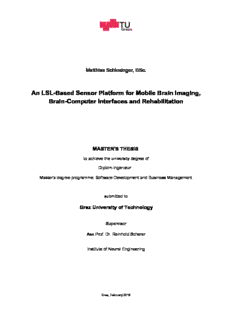
An LSL-Based Sensor Platform for Mobile Brain Imaging, Brain-Computer Interfaces and ... PDF
Preview An LSL-Based Sensor Platform for Mobile Brain Imaging, Brain-Computer Interfaces and ...
Matthias Schlesinger, BSc. An LSL-Based Sensor Platform for Mobile Brain Imaging, Brain-Computer Interfaces and Rehabilitation MASTER'S THESIS to achieve the university degree of Diplom-Ingenieur Master's degree programme: Software Development and Business Management submitted to Graz University of Technology Supervisor Ass.Prof. Dr. Reinhold Scherer Institute of Neural Engineering Graz, February 2016 Matthias Schlesinger, BSc. Eine LSL-Basierte Sensor Plattform für Mobile Hirnforschung, Gehirn-Computer Schnittstellen und Rehabilitation MASTERARBEIT zur Erlangung des akademischen Grades Diplom-Ingenieur Masterstudium Softwareentwicklung - Wirtschaft eingereicht an der Technischen Universität Graz Betreuer Ass.Prof. Dr. Reinhold Scherer Institut für Neurotechnologie Graz, Februar 2016 Abstract Even though the brain proves constantly that it performs amazingly well in complex, ever-changing environments the majority of brain research is conducted while participants sit or lie motionless. Similarly, while the ultimate goal of brain-computer interface (BCI) systems is to aid patients in need, hardly any BCI system can be used by a patient at home without a supervisor present. Rehabilitation exercises, however, can be done by patients at home but due to their repetitive, monotone nature are often neglected. Those seemingly unrelated statements express one and the same challenge: the transition from a stationary to a mobile environment or in other words the challenge of making technologies usable outside the laboratories and medical clinics to advance research and aid patients. The aim of this thesis was to further explore the three fields mobile brain imaging, mobile BCI and mobile rehabilitation. Firstly, the requirements those areas impose on both hardware and software were assessed. For hardware devices those requirements include being lightweight, portable and ideally wireless. Software is required to be able to synchronize multiple devices, be easytouseandnottorelyonproprietarysoftware.Furthermore,bothhardware and software should be affordable for patients that already have to bear high medical costs. Based on those results the data acquisition and synchronisation software Lab Streaming Layer (LSL) was extended so that it supports hardware devices that facilitate this before-mentioned transition. Those hardware devices include medical-grade hardware for mobile brain research such as the ANT eegosports amplifier(ANTNeuro,Enschede,Netherlands)andtwodatagloves,namely,the 5DT DataGlove (5DT, Gauteng, South Africa) and the CyberClove (CyberGlove Systems, San Jose, CA, USA) but also affordable consumer-grade devices such as the Leap Motion controller (Leap Motion Inc., San Francisco, CA, USA) or the Thalmic Myo wristband (Thalmic Labs Inc., Ontario, Canada). All this yields a software platform that can easily access and synchronize a wide range of hardware devices. To demonstrate its usefulness for mobile rehabilitation a proof-of-concept for a computer game for rehabilitation is presented. The game uses two of the newly implemented devices to control the v main character and LSL to record the data coming from those devices as well as in-game events. vi Kurzfassung Obwohl das menschliche Gehirn permanent beweist, wie gut es komplexe Situationen meistern kann, werden Teilnehmer in Hirnforschungsstudien dazu angehalten, sich so wenig wie mo¨glich zu bewegen. Gleichzeitig ist es zwar ausgewiesenes Ziel von Gehirn-Computer Schnittstellen (auch: brain-computer interfaces, BCIs), Patienten zu helfen. Tatsa¨chlich bei Patienten zu Hause zum Einsatz kommen aber ob ihrer Komplexita¨t nur sehr wenige BCI Systeme. Phys- iotherapeutische U¨bungen zu Rehabilitationszwecken, andererseits, ko¨nnten zwar durchaus zu Hause durchgefu¨hrt werden, scheitern aber oft an der fehlen- den Motivation der Patienten. Auf den ersten Blick mo¨gen diese Feststellungen etwas beliebig gewa¨hlt sein. Bei genauerem Hinsehen offenbaren sie allerdings ein und dieselbe Herausforderung: den U¨bergang von einer stationa¨ren in eine mobile Umgebung oder, mit anderen Worten, die Herausforderungen, Tech- nologien außerhalb von Forschungseinrichtungen und Kliniken verwendbar zu machen, mit dem Ziel, Forschung voranzutreiben und Patienten zu helfen. Das Ziel dieser Arbeit war es, die drei Felder mobile Hirnforschung, mo- bile Gehirn-Computer Schnittstellen und mobile Rehabilitation und die An- forderungen, die sie an Hardware und Software stellen, zu erforschen. Zu den Anforderungen za¨hlen die Verwendung portabler, kabelloser Hardwaregera¨te sowie benutzerfreundliche Software, die in der Lage ist, mehrere solcher Hard- waregera¨te zu synchronisieren. Außerdem sollten fu¨r sowohl Hard- als auch Software leistbare Lo¨sungen angeboten werden, um Patienten, die ohnehin schon hohe Ausgaben zu tragen haben, nicht weiter zu belasten. Ausgehend von diesen Ergebnissen wurde die Software Plattform Lab Stream- ing Layer (LSL) erweitert, so dass Hardwaregera¨te, die den oben genannten U¨bergang in eine mobile Umgebung erleichtern, unterstu¨tzt werden. Zu den implementierten Gera¨ten za¨hlen medizinische Gera¨te wie der ANT eegosports EEG-Versta¨rker (ANT Neuro, Enschede, Netherlands) und zwei verschiedene Datenhandschuhe, und zwar der 5DT DataGlove (5DT, Gauteng, South Africa) und der CyberGlove (CyberGlove Systems, San Jose, CA, USA), aber auch gu¨nstige Consumer-Gera¨te wie der Leap Motion Controller (Leap Motion Inc., San Francisco, CA, USA) oder das Thalmic Myo Armband (Thalmic Labs Inc., Ontario, Canada). vii Abschließend wird die Praktikabilita¨t der entstandenen Software Plattform am Beispiel der spielbasierten Rehabilitation demonstriert. In diesem Mach- barkeitsnachweis werden zwei der neu implementierten Gera¨te sowie LSL zur Erfassung des Spielfortschritts genutzt. viii
Description: